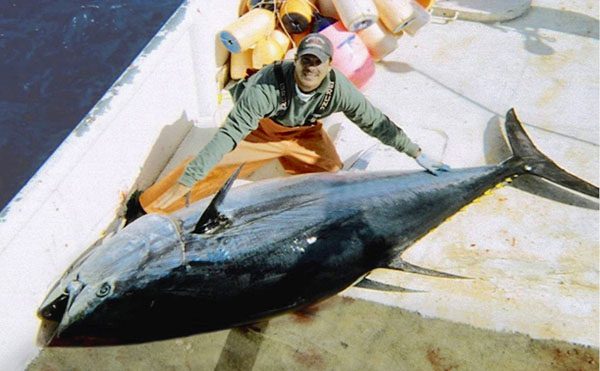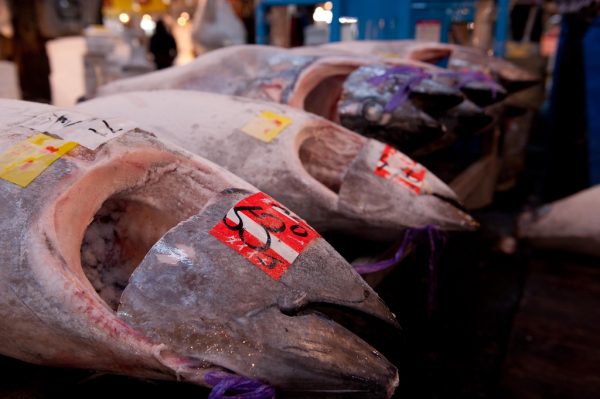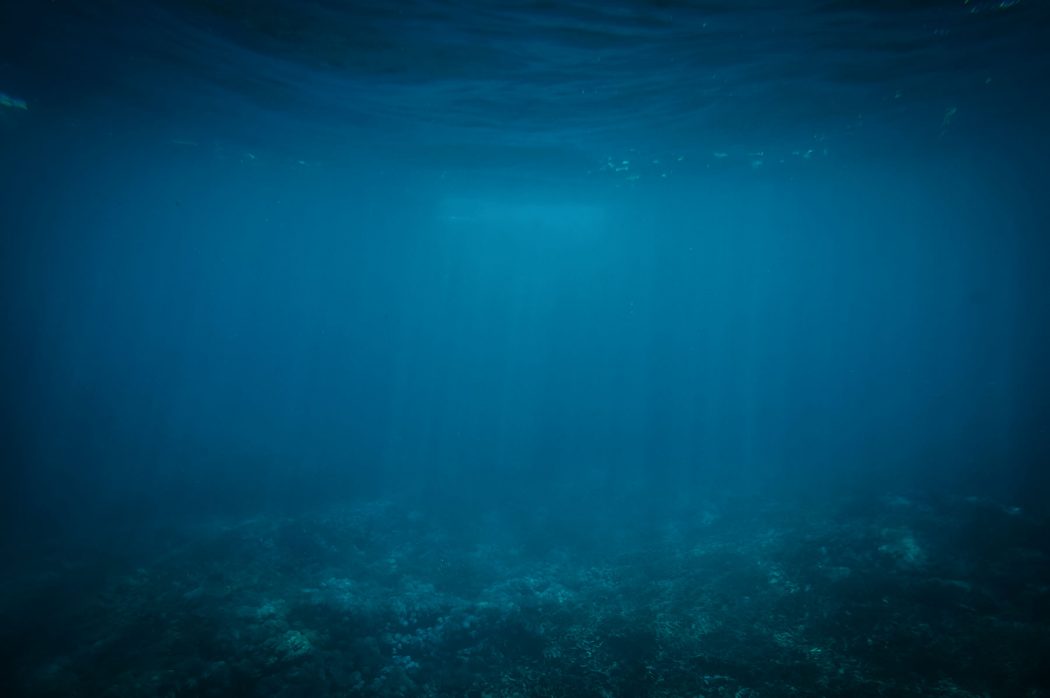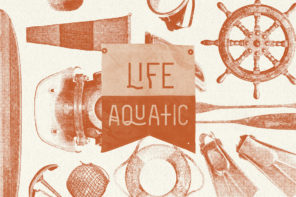Winter was in the air as we headed out into the cold rough waters of the Gulf of St. Lawrence on a frigid day in late autumn. There was a mix of rain, hail and snow in the morning, but the clouds gave way revealing a beautiful sunrise over a disorganized sea. We were heading out to find and harvest one of the most majestic and highly valued fish in the ocean, the Giant Bluefin Tuna.
As a scientist, I had spent years studying these amazing fish, and had seen, caught, tagged and released hundreds of them, but not the size of the fish found in these cold waters off of Nova Scotia. These are the waters where the 1000 pounders still swim in numbers. On this cold blustery morning, I’m on a mission to photograph and document the beginning of the journey of the Bluefin from the ocean to the Tsukiji Market in Tokyo where they are prized like no other fish.
One of the largest fish in the ocean, Bluefin are incredible, often reaching sizes in excess of 1000 lbs and lengths over 9 feet. The world record catch was a 1,496 lb fish caught in 1979 off of Nova Scotia. Plain and simply, these fish get massive.

A sizable Bluefin on deck. Photo: Wikicommons
A highly migratory species, they have many adaptations for life in the open sea, allowing them to travel into warm and cold waters and over tremendous distances. Fish caught and tagged on the east coast of the United States can cross the Atlantic Ocean to Europe in just a few weeks. Like streamlined bullets, these fish can reach speeds over 60 mph as they travel in search of food, and to spawn in either the Gulf of Mexico or Mediterranean Sea.
As we put the lines in the water, we saw pilot whales feeding and birds plunge diving on bait all around. These were all good signs that the tuna were nearby. Moments later, in the distance, we saw large splashes. Not a moment after, thousand pound giant tunas busted out of the water soaring through the air. Everyone gasped at the sheer size and grace of these huge fish. We all quickly forgot about our frozen hands and the piercing wind with every leap of these fish. In the midst of the excitement, and with our bait in the water, another tuna busted clear out of the water not more than 10 feet off the stern of the boat…and we were hooked up.
After two hours and with tunas still jumping all around, we got a glimpse of the silver and gold of the back of the giant tuna on the line. Moments later he broke the surface and then the fight was over and the careful handling of the fish to get it ready for market started. Finally with the tuna on board and packed with ice, we headed back to the dock where the tuna buyers would be waiting to assess the fat content and quality of the fish.
As a scientist and conservationist, I have always highly valued the skills and importance of commercial fishermen. Working with and learning from these fishermen has always been of the utmost importance to me. No one knows or understands the ocean and fish like the men and women who spend their life on it, and as a scientist, it was my job to learn from them and build on their knowledge to create sustainable fisheries for future generations. With Bluefin tuna, this is a difficult task because of their tremendous value at market.

One of the many markets where Bluefin is bought and sold. Photo: Wikicommons
The fish harvested here in Nova Scotia are destined for the tuna auctions in the Tsukiji Market in Tokyo. Nearly every Bluefin caught across the globe is carefully handled, packed in ice and shipped halfway around the world to Tokyo where it is highly valued in the sashimi market. If you talk to any Bluefin fishermen, they would tell you it is sacrilege to cook a Bluefin. The red fatty meat of the tuna is said to taste like the ocean and for this reason, it is the most valued of all of the fish. In fact the most expensive Bluefin ever auctioned was sold for $1.76 million dollars in 2013! That translates to over $3,606 per pound!
While the value of Bluefin has soared in recent years as the populations have declined, there has always been fishing pressure on them. Bluefin have been harvested and prized in the Atlantic Ocean and Mediterranean Sea for thousands of years. Aristotle wrote of the quality of their meat and of the importance of their great migrations over 2000 years ago. Bluefin were so important and valued, they were often depicted on gold coins and in art.
At the turn of the 20th century, in North America, however, this was not the case. Prized by sportfishermen for their fight, they had little commercial value until the advent of modern refrigeration. A Bluefin, not unlike the one sold for $1.76 million would have been discarded after being weighed. This all changed when the tuna buyers from Japan needed to look beyond the once prolific tuna grounds in their local waters off of Japan for Bluefin to fill their coffers and insatiable appetite for the highest quality and fattiest cut of the tuna, the toro. Quickly the market in the Atlantic grew and fishermen were making record amounts of money for their catches.
Check out: The Beginning of the End with Legendary Montauk Fisherman, Bill Akin
With the increase demand, populations of Bluefin worldwide plummeted and prices soared. The insatiable appetite for Bluefin in the Japanese and world market has taken its toll on the populations and this demand, despite the high prices, has not ceased to increase. Bluefin prices are more analogous to prices of luxury goods, like diamonds or other precious metals, than that of other fish. This creates tremendous challenges in their management. Bluefin populations are less than 10% of what they were in the 1970s and in the Pacific, the population is estimated to be less than 4% of their historic levels. These populations are in dire straits.
Scientists have been working for decades to unlock the mysteries of the Bluefin. While the commercial fishermen head out into the cold waters off of Nova Scotia, another boat filled with scientists and local fishermen head out with a different mission, to electronically tag these fish to learn about where they go in the ocean in hopes of keeping them there for the future. The Tag-A-Giant program, led by Stanford Professor, Dr. Barbara Block, has tagged thousands of Bluefin in both the Atlantic and Pacific Oceans revealing some of the secrets of the movements and habits of these incredible fish. I was lucky enough to meet Dr. Block and begin working with the Tag-A-Giant program while in graduate school, and it has been a privilege to continue to work with them today.
Bluefin prices are more analogous to prices of luxury goods, like diamonds or other precious metals, than that of other fish.
Using the same rod and reel fishing techniques of the commercial fishermen, the scientists and crew catch the Giants and instead of using a gaff, they carefully bring the fish on board, give it some jewelry, i.e. electronic tags, and send it on its way to collect data. The tags are complex mini computers, collecting and recording location, depth, and temperature data. These tags pop off the fish at a given time and send emails with the information via satellite back to the lab where the data is analyzed revealing the secrets of the tuna.
From these tags, we have learned about the complex migratory patterns of the fish, where they are going, and when they are going there. We know that some of the fish tagged off of North America are traveling across the ocean to feed and spawn in the Mediterranean Sea while others stick along the coast and head south to spawn in the Gulf of Mexico. All of this data is extremely helpful in making management decisions. I have worked with Tag-A-Giant for years and, as exciting as it is to see and catch the fish, that excitement is matched, if not exceeded, when the tag data comes in revealing the once secret life of the Bluefin.
The hope is that the international management body looking after the bluefin stocks will use this information to make better decisions for the management of these incredible fish. Unfortunately, due to their high market value, even when we, as scientists, know what needs to be done to keep bluefin in the ocean for years to come, the managers often do not make the best decisions for the species.

Post-auction. Photo: Wikicommons
As consumers, we can choose not to eat bluefin, the toro and maguro from high-end sushi restaurants. In fact many prominent sushi chefs are realizing the state of the populations and deciding not to serve these precious fish so that their children and grandchildren may have the opportunity to see them and hopefully eat them in the future. I, for one, never want to see the day when Bluefin are not in the ocean and the possibility of seeing that huge fish soar through the air does not exist. A Bluefin tuna is like the ocean; it is mysterious and powerful, and demands respect.
As the first Bluefin auction of the year approached in January of this year, everyone from scientists to fishermen to lovers of sashimi, were watching to see how much the auspicious first fish of the year would sell for. Would it command the nearly 2 million dollars as it did in 2013? Or would it go for less? The answer came on January 4th when the first Bluefin of the year, a 467 lb Pacific Bluefin caught in the waters off of Japan was sold for 74.2 million Yen, $634,000, or $85 for a single piece of sashimi.
Words by Gaelin Rosenwaks | @GaelinGOEplore, as featured in the 2017 Winter Issue of Whalebone Magazine.










